Intel X58 Motherboard Roundup - What does $300 Get You?
by Gary Key on December 5, 2008 3:00 PM EST- Posted in
- Motherboards
SATA Performance
PCMark Vantage is the latest benchmark available from Futuremark, and it is only for use with Windows Vista. Similar to the venerable PCMark05 in its makeup, Vantage modernizes the criteria and test methodology to reflect what users may encounter when running the new Windows OS and current applications. The total HDD benchmark is roughly 87% reads and 13% writes in nature. We run each test five times per drive, producing a median score that we use for comparison in our charts. We utilize AHCI settings for each board.
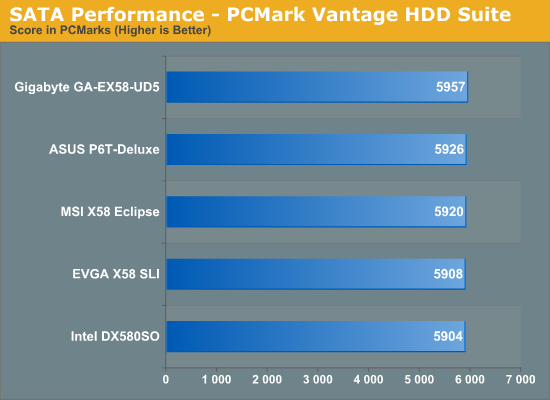

All of the boards utilize the ICH10R for primary storage duties, so there is little difference between the results. In our secondary controller results, we see the SAS solution from Marvell leading the JMicron controllers utilized on the other boards. The MSI and Gigabyte boards both utilize the JMB322 chipset, but we see the MSI board performing better since the JMB322 resides directly on the PCIe bus instead of utilizing the JMB363 as a pass through chip in the same manner that Gigabyte does. EVGA uses the JMB363 chipset and it just barely slides past the Gigabyte setup.
USB / FireWire Performance
Our USB transfer speed tests are conducted with an OCZ Rally 2 Turbo 4GB Flash Drive and USB 2.0/FireWire based Maxtor OneTouch II external hard drive. In the small file test, we transfer a 602MB file folder containing 444 files of various sizes from our hard drive to the USB Flash drive. In the large file test, we transfer a 1.90GB file folder containing 17 different files from our hard drive to the external drive utilizing the USB 2.0 and IEEE 1394a interface.
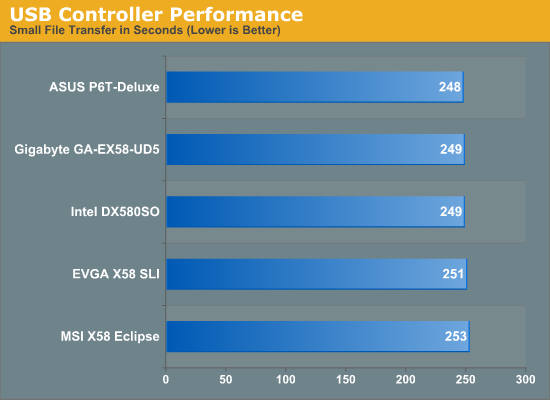
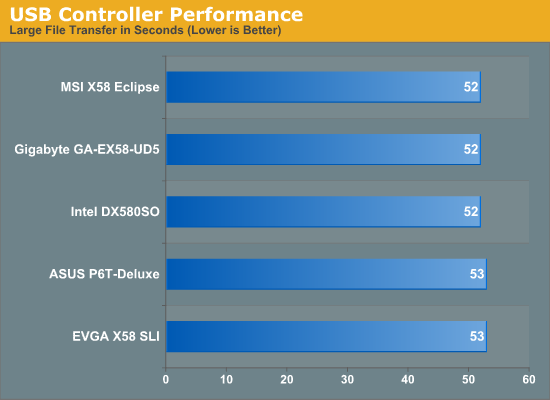
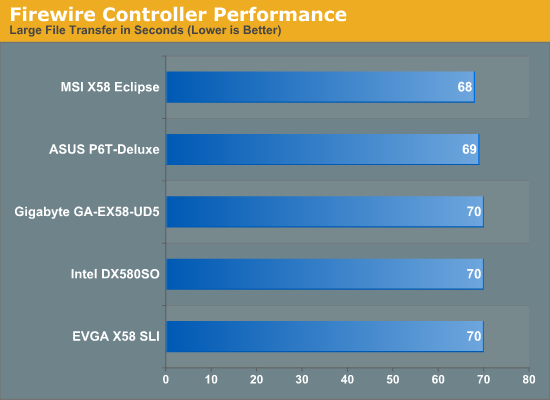
USB performance should be a wash since all the boards use the same ICH10R chipset that provides the USB capabilities. While our synthetic HD Tune tests indicate parity between the boards, the actual transfer of files in the small file test indicates a slight advantage to the ASUS, Gigabyte, and Intel implementations. Our large file USB test is basically a wash as the external hard drive becomes the limiting factor. The VIA FireWire solution on the MSI and ASUS boards hold a small advantage over the Texas Instruments chipset on the other boards.
Networking
The Windows 2000 Driver Development Kit (DDK) includes a useful LAN testing utility called NTttcp. We used the NTttcp tool to test Ethernet throughput and the CPU utilization of the various Ethernet Controllers used on the Intel motherboards. We set up one machine as the server; in this test, an Intel system with an Intel CSA Gigabit LAN connection. Intel CSA has a reputation for providing fast throughput and is a logical choice for our Gigabit LAN server.
On the server side, we used the following Command Line as suggested by the VIA whitepaper on LAN testing:
Ntttcpr -m 4,0,‹server IP› -a 4 -l 256000 -n 30000
On the client side (the motherboard under test), we used the following Command Line:
Ntttcps -m 4,0,‹client IP› -a 4 -l 256000 -n 30000
At the conclusion of the test, we captured the throughput and CPU utilization figures from the client screen.
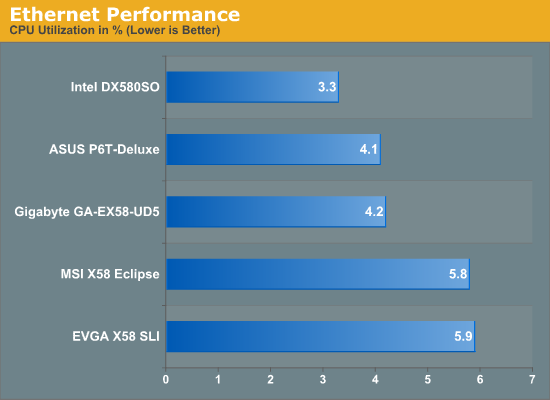
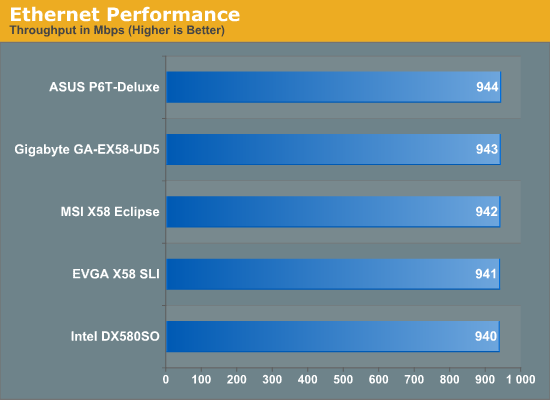
Our network throughput test indicates how well a particular controller design from Realtek, Marvell, or Intel performs instead of being indicative of true chipset performance. This also holds true for the CPU utilization results, though this test can also be influenced to certain degree by the BIOS code and chipset interconnect design.
The CPU utilization numbers favor the integrated GbE controller on the Intel board, followed closely by the Marvell chipset on the ASUS board. The EVGA, MSI, and Gigabyte boards use similar Realtek networking chips, but the Gigabyte board uses the newer RTL8111D over the MSI/EVGA RTL8111Cs. All of the boards feature excellent throughput, with the Marvell solution edging slightly ahead of the Realtek and Intel solutions.










78 Comments
View All Comments
Elvis2 - Sunday, December 7, 2008 - link
i'm tired of being a free beta tester for these "top" tier manufacturers (remembering my E7205 days). If I'm going to spend $300.+ on a motherboard, I expect it to work AS ADVERTISED. I used to upgrade every year but for the past couple, I've been hesitant to do so. I don't want to fork over my hard earned cash (particularly in this economy)for a new rig only to spend hours on the phone with some tech support guy that dosen't know half of what I do ( let's start on page ten ok?)and wait weeks for a bios that corrects the problem. My Opty rig has been incredibly stable while producing a 50% o/c (thanks eVGA)but is getting long in the tooth. I run SLI and have been waiting on an Intel chipset that supports it. I'm going back to intel and the i7 920...maybe. I'm going to wait a couple of months tho. Bleeding edge, spending that kind of coin, and the hassle of working out the bugs, after fifteen years it's not worth it to me.Sorry for the rant. Jmh $.02.
btw, great article.
fausto412 - Sunday, December 7, 2008 - link
There isn't one board manufacturer thatdoesn't have a bunch of people complaining in the forums all over the internet. Anand's opening explains why.I hate upgrading bios expecting better stability or performance and getting more problems or no fixes.
Gary, i think it is time to have some kinda of database that covers all boards and their known issues going back 2 years or to the 3 series boards. if the flag ship board has a problem then by extension lower end boards have that problem. if they didn't care to make their product the best then that is their problem. GIVE THEM BAD REVIEWS so that they get on the ball.
I never knew Anandtech went back and forward with the board makers as if you're beta testers.
We need to do something to make things better
strikeback03 - Monday, December 8, 2008 - link
I'd argue that it is entirely possible for the flagship product to have problems that lower-end products do not. Expensive X58 is the only option for now for i7 processors, but look back at LGA775. I wouldn't be at all surprised if some stability compromises were made on X38/X48 boards in pursuit of higher SuperPI numbers, while those same compromises are probably not present in the mainstream P35/P45 boards of the same age. Motherboards are one area where I can see going with a mid-level (~$90-130 for LGA775) product might give a better result for the majority of users than jumping to the high end would.borneoo - Sunday, December 7, 2008 - link
Beside the GHz, and MB/s would be good to have a chart/list, which shows the problems of the parts, and aggregated charts to show problems belongs to the same company, ... or SEARCHABLE DATABASE about errors related to products / companies and solutionsJonnyDough - Sunday, December 7, 2008 - link
"Our plan is to cycle through each manufacturer so we are not singling out any one supplier but we are going to be brutally honest in our assessments in these particular focus reviews." (the quote button never works for me in Firefox. Plz fix)Awesome. At least someone is. I think a "two strikes before we post" policy is fair.
DandAG - Sunday, December 7, 2008 - link
After reading the first page of this article “Intel X58 Motherboard Roundup - What does $300 Get You?”, I started reading all the blogs. At first I agreed 100% with Anand’s comments, and wanted to jump on the band wagon like everyone else, but then I read some of the response. Realistically, review sites can’t use the boards under test with ALL the different software/hardware configurations consumers will, and they cannot postpone a review until all the BIOS and operating bugs are fixed…they would be releasing a review a year (or more) after the next generation hardware has already hit the market. People don’t visit these review sites to see how good a DDR2 system is compared to a DDR system, they come to these sites to read about the future, to get the “inside scoop” as to what the manufacturers are thinking up next, and to see the new features of hardware out there today because they are thinking of upgrading right now. To read about overclocking and performance comparisons is really just a bonus for the overwhelming majority. Most people just jump to the conclusion page to see if the reviewer recommends the product or not. We’ve all done it.Review sites need the merchandise to review and the funds to stay afloat, so upsetting certain manufacturers is not in their best interest. They can get away with critiques, questions, “less than expected” reviews, and some (very little) criticisms, but if they were to only give bad reviews every time, manufacturers would stop sending them products to review. And if you think that is a good thing, “they’ll just purchase the final release like the rest of us and provide a balanced review”, think again. If a review site did that, 1) it would have to advertise like crazy to maintain its purchasing ability, 2) not be able to provide future analysis, 3) and not provide the consumer anything more than what “free” chat rooms/manufacturer message boards give you.
I agree there needs to be an industry-wide change; a change in R&D, change in QC, and a change in review process and reporting, BUT the real change has to come from the consumer. We the purchasers of their merchandise have to take a stand, bite the antiquated hardware bullet, and wait to buy until all the bugs are fixed (at least to a reasonable state). As long as we continue to want to be “the first” or “the fastest”, manufacturers will continue to scramble to be first on the market with crap that can or cannot be fixed later on.
Don’t jump down the throats of review sites like AnandTech; instead tell them what YOU want to read about. Give these sites constructive criticism, and suggestions to better themselves like Christoph, Gary, Anand, and all the other reviewers here give the manufacturers. The old “if you don’t have anything better to say, then don’t say anything at all” thing.
Personally, I would love to have AnandTech continue to review the next best thing before it hits the market just to see what the manufacturers are planning and whether or not the reviewer thinks upgrading will be worth it, BUT I also want them to then purchase that same item over-the-counter for a “final look” review, and then tell it like it is. Of course that can’t be done with all items initially reviewed (too time consuming), but the items that bloggers have shown the most interest in.
Steve Z - Sunday, December 7, 2008 - link
First, kudos for reqiring reliability. I've now bought the ASUS board. I won't overclock because I know what gate stress does to CMOS electronics (I slowly destroyed a chip I was testing at an elevated voltage. 18 hours is not enough time to run a $300 CPU). I use my computer to get work done and view overclockability as an indication of robustness in the board's engineering. If it's not - I need to know this. Thank you Gary and Anand - beleive me, $100 extra is a small price to pay for a motherboard that will not waste days of my time trying to get it to work.Second, a notice to those of you who are going to buy the ASUS board. They put the "Crash Free BIOS utility" and the driver installation utility on the same CD. Since installing all the drivers takes 3 restarts, imagine my surprise when installing the ethernet drivers did several surprise BIOS flashes (I didn't even know what was happening at first and I reset the system a few times during the process. To ASUS's credit, the board recovered).
If I pay $300+ dollars for a board, I expect them to pay the extra 5 cents and include a second CD. When you go through your three restarts, make sure you remove the disk every time then put it back in once the OS starts up. Shame on you ASUS for the oversight.
That said, everything is working well now. I hope I didn't buy a product from the company who thought it was only OK for 3 GB to run reliably as I'm running 6 GB now and will go up at some time in the future since I run math sims.
cheers,
--Steve Z.
RagingDragon - Sunday, December 7, 2008 - link
Reading the sections on each board, I think the ASUS was the only board which fully worked, out of the box, with 12GB of RAM. This strongly implies they were *not* the 3GB company.It's hinted the Gigabyte had some undescribed issues with 12GB and older BIOS's, and it's stated that the EVGA also had undescribed issues with 12GB (no indication whether those issues were at stock speeds or when overclocking). The MSI still has issues overclocking 12GB or RAM - nothing said about whether it worked at stock speed out of the box.
LeeKay - Saturday, December 6, 2008 - link
I bought the GA-EX58-Extreme as I posted in the forums the quality of the board is the best I have seen but support wise and bios wise this board sucks worse than any board I have had. For a motherboard to have issues when I use 12GB is beyond me. I want to use this pc for everything from online banking thru gaming for the wife my son and me and to do video editing. Right now I can just run Need for speed undercover at any resonable clock speed without it crashing. Thats as of F4j. And I still can not let my board go to sleep with S3 enabled nor can I expect my Data drives running on the hardware raid controller to recover in S3 mode nore can I run my pc with any of the energy saving options in the bios. Oh and I cannot run my memory at 12gb and at 1600Mhz just noway in hell it will be stable. I have to run it at 1333mhz. I cant run SLI and have my X-FI PCI sound card in either PCI slot and have the pc boot into windows. It just blue screens with the latest Bios. (I am running 2 280GTX with single slot active cooling).The good note is to run at 4.13ghz I am running 1.425v without loadline correction. its stable and with the above taken into account far better tha the past issues.
Sunsmasher - Saturday, December 6, 2008 - link
Your comments are extremely well thought out and relevant.The idea that $300(!) motherboards don't work reliably upon release
is beyond ridiculous.
I think your plan to write an as-is review initially in a great idea.
This will give early buyers a true heads-up on what they're getting.
And then later, you can perform your invaluable beta feedback service to the manufacturers and your readers.
Hopefully, this policy will cause improvements on the QC end.
Thanks again for being so on top of it!